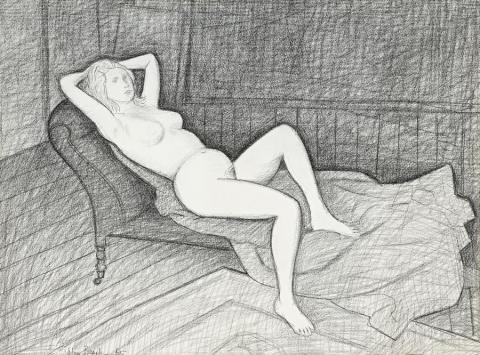STUDY FOR 'THE MERTZ NUDE', 1965
JOHN BRACK
conté on paper
48.5 x 65.0 cm
signed and dated lower left: John Brack 65
Laurence Course, Melbourne, a gift from the artist
Thence by descent
Private collection, Melbourne
The Mertz Nude, 1965, oil on canvas, 96.3 x 129.4 cm, Commissioned by the Mertz Collection of Australian Art, illus. in Grishin, S., The Art of John Brack, Oxford University Press, Melbourne, 1990, vol. II, cat. o150, pp. 21 and 132
According to John Brack's work records, the painting Nude in Red Room, 1965 was commissioned by Harold Mertz, the New York businessman who was advised by Kym Bonython. Brack's first use of the Persian carpet appeared in 1965 in his Portrait of Hal Hattam, the Melbourne gynaecologist, followed by the Mertz commission.
'In general the setting is intended to reflect the present real world, i.e. it is a corner of my own studio, with only a Persian rug, apart from the subject to link it to the past, and to provide a contrasting note of opulence, if not a particularly strong one'.1 The subject of this drawing relates closely to the later painting Reclining Nude, 1970.
'The new series of nudes, when compared with the two series that preceded it, has a startling complexity, sophistication and subtlety. The conceptual elements remain relatively constant. The nude, who in her pose frequently echoes an artistic convention, generally refers to the past and to tradition; the bare studio with its naked walls and plain receding floorboards, refers to reality and the present situation; where the oriental carpet "the carpet paradigm" as if separating the two worlds nevertheless forms a strange physical bridge between them. The Reclining nude, 1970, was one of the most successful paintings of the series. The pose of this somewhat heavy-bodied model with her hands folded behind her head is derived from the Odalisque of Ingres, an icon of languorous sexuality, but the world in which Brack's model is placed totally lacks Ingres's sense of repose and stability, and instead of the measured grid of verticals and horizontals the principal compositional lines are oblique.'2
1. John Brack, letter to Ian North, 30 May 1972, quoted in Grishin, S., The Art of John Brack, Oxford University Press, Melbourne, 1990, vol. I, p. 118
2. Grishin, ibid.
